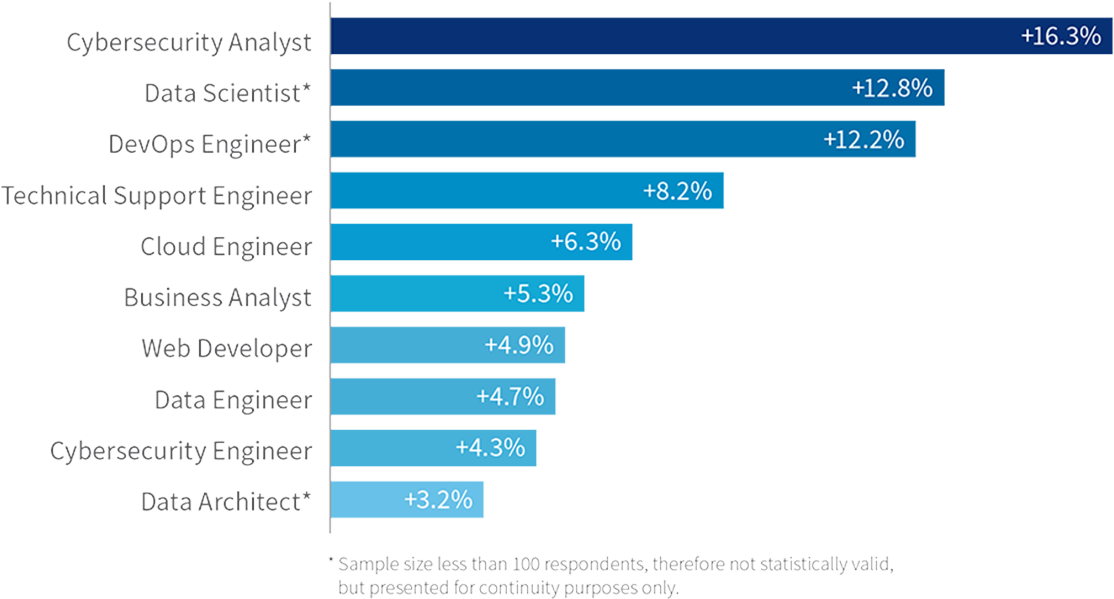
Contributed by Tom Agbugui, GDI Infotech

The Topic of Change
One thing that’s consistent about the tech industry is change. Over the last couple of decades, we’ve seen rapid change in technology, methodology, salary expectations, and priorities for companies across the globe. Then, the coronavirus happened.

With a deadly pandemic the likes of which have never been seen before, a new change had to happen: change in environment.
With it came a necessary overhaul in how companies do business. This one change has reflected across all other aspects of the tech industry in interesting new ways. We now have the data to show how that change affected the way talent partners and workers within the tech industry think about their jobs and responsibilities in that space.
Working from Home
According to a survey from Indeed, a leading American job listings platform, an overwhelming majority of tech workers, 96 percent, believe that working from home is here to stay. Out of those given the option to work from home permanently by their company, 95 percent of those surveyed have taken their employers up on that offer. With six out of 10 tech workers willing to take a pay cut in order to continue working from home.
Clearly, virtual work appeals to the current work force. The major reason that it does is because of increased flexibility, a significant reduction in the commute, and a better work-life balance.
Primary Tech Industry Trends
Besides an increased interest and desire to work from home, there are three major industry trends that we can look forward to. These industry trends were always likely to happen, but thanks to the pandemic, the rate at which these trends are being adopted has increased dramatically.
We’ve talked quite a bit about this topic in our Thriving In a Post Pandemic World series where we’ve talked to CIOs from La-Z-Boy and Visteon Corp about how industry leaders and employees can not only survive but thrive during and after the pandemic.
Among the many ideas and themes discussed, three major trends stuck out as areas of interest for business leaders in the tech industry:
- A strong emphasis on digital transformation efforts
- Reskilling and readjusting the workforce
- An analysis on where and how manufacturing happens
Jobs with High Growth
To show how the three trends above affect the job market, we’ve curated a collection of data that can help you understand the impact. Here are the jobs that have had the most increase in demand over the last year.
In the table below from cio.com, here are the top 10 most in-demand tech jobs for 2021.
| Job | 25th percentile | 50th percentile | 75th percentile | 95th percentile |
|---|---|---|---|---|
| Security professional (information, systems, network, data, cloud) | $124,250 (information); $100,000 (systems); $105,500 (network); $112,500 (data) | $149,000 (information); $120,500 (systems); $124,500 (network); $134,000 (data) | $179,000 (information); $143,500 (systems); $148,250 (network); $159,750 (data) | $213,000 (information); $168,500 (systems); $174,500 (network); $190,000 (data) |
| Cloud architect | $121,000 | $146,000 | $174,500 | $202,250 |
| Database administrator | $79,750 | $100,750 | $120,500 | $160,000 |
| Programmer analyst | $88,750 | $109,500 | $131,000 | $154,500 |
| Systems analyst | $81,250 | $96,500 | $115,500 | $136,750 |
| Mobile applications developer | $112,750 | $135,750 | $161,750 | $189,750 |
| Network administrator | $78,500 | $95,250 | $113,500 | $133,500 |
| Software developer | $97,250 | $118,250 | $138,000 | $165,000 |
| DevOps engineer | $97,000 | $120,000 | $143,000 | $184,750 |
| Help desk and desktop support professionals | $35,250 (tier 1); $41,500 (tier 2); $50,750 (tier 3) | $40,500 (tier 1); $50,000 (tier 2); $60,500 (tier 3) | $47,500 (tier 1); $56,500 (tier 2); $72,250 (tier 3) | $57,250 (tier 1); $67,000 (tier 2); $82,000 (tier 3) |
And here are the top jobs with an increase in salary expectation (source: Dice.com):

From the data, we can determine that most of the jobs with high demand are designed to facilitate a new online, remote work, mobile workflow. There’s an increased emphasis on cybersecurity and cloud solutions, along with a demand for web and mobile developers to smooth the path for users to easily interact with the platforms being built.
The job market is actively responding to the industry trends listed above. Digital transformation has become a must. According to Raman Mehta from Visteon Corp “We don’t even think about cloud first. We say cloud only.” For the team at Visteon Corp and other companies like it, the intersection of emphasizing digital transformation, for an advanced manufacturing process requires a new kind of workforce. The kind that’s reflected in the graph and tables above.
With that also comes a change in the types of programming skills that are in demand. Here are two technologies worth highlighting.
AWS
Moving to the cloud was critical for survival for a lot of companies when it felt like the world stopped due to the pandemic. The good news is that cloud migration was quickly becoming part of our inevitable future. We just didn’t see it coming as fast as it did. As more companies have migrated their data platform to the cloud — AWS has remained top of mind. As these companies continue to build out more and more sectors of business into the cloud- the AWS skillset is quickly becoming a demand that won’t slow down in the near future. Salaries for developers with AWS range from $70-130K according to data from recruiters at GDI Infotech.
React.js
Over the past year, we have seen an increase in demand for React.js as more and more companies invest in their online presence. React allows for simplistic views of websites and coding that is much easier to debug. This is a great investment for many UI/UX developers, Full stack developers, and anyone with interest in designing web based technologies. React Salaries under GDI range from 80-150K according to data from recruiters at GDI Infotech.
Conclusion: Thrive with the Change
The tech industry is changing rapidly. But then again it always does. Industry leaders, employees, and job searchers should stay aware of what those changes are and what they look like so that they can figure out how best to bring value and grow within their careers. To stay updated on how the tech industry is evolving, and for updates on new jobs and opportunities within the tech industry, subscribe to the GDI Careers platform.